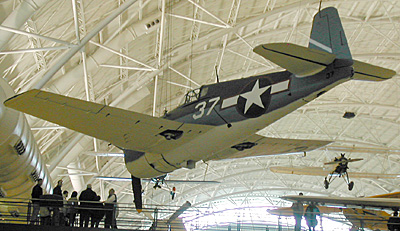 The most successful fighter of the Pacific campaign, shooting down 5156 Japanese aircraft for the loss of only 270 of its own number in air-to-air combat; the F6F was designed from the spring of 1941 as an F4F successor.
The most successful fighter of the Pacific campaign, shooting down 5156 Japanese aircraft for the loss of only 270 of its own number in air-to-air combat; the F6F was designed from the spring of 1941 as an F4F successor.
F6F Hellcat hanging from the roof.
It was in effect an enlarged and better streamlined F4F with a considerably more potent engine, and the XF6F-3 first prototype flew in June 1942. The F6F-3 initial production model (4402 aircraft including 205 F6F-3N night-fighters and 18 radar-equipped F6F-3E night intruders) entered combat in August 1943, and soon revealed a superb balance of high performance, hard-hitting firepower, great strength and adequate agility. Some 252 of the standard fighters were transferred under Lend-Lease to the UK for service with the Fleet Air Arm with the designation Gannet Mk I soon changed to Hellcat Mk I.
Country of origin: USA
Type: (F6F-3): single-seat carrierborne fighter and fighter-bomber
Powerplant: one 2000hp (1491kW) Pratt & Whitney R-2800-10 or-10W Double Wasp 18-cylinder two-row radial engine
Performance: maximum speed 603km/h (375mph); initial climb rate 1067m (3500ft) per minute; service ceiling 11705m (38,400ft); range 2559km (1590 miles)
Weights: empty 4128kg (9101lb); maximum take-off 7025kg (15,487lb)
Dimensions: span 13.06m (42ft 10in); length 10.24m (33ft 7in); height 3.99m (13ft tin)
Armament: six 0.5in fixed forward-firing machine guns in the leading edges of the wing, plus an external bomb load of 454kg (1000lb)
Text from: Aircraft of WWII by Chris Chant (Fiedman/Fairfax, 1999, ISBN: 1-58663-303-1), a handy book with specs for 300 aircraft.
WWI
WWII
Japan: Kawanichi N1K2-Ja Shinden Kai (George)
US: Curtiss P40 Tomahawk
Post WWII
US: Northrop N-1M Flying Wing
Other
UHC Displays
Germany: Focke-Wulf FW-190F
Germany: Arado AR-234B
Germany: Junkers JU-52/3m
Germany: Focke-Achgelis FA-330A
Germany: Rheintochter R1 Anti-aircraft Missile (Rhine Maiden)
Japan: Kawasaki Ki-45 Kai Toryu (Nick)
Japan: Aichi M6A1 Seiran
Japan: Kugisho Ohka Model 22 Cherry Blossom
US: Vought F4U Corsair
US: Lockheed P-38J Lightning
US: Boeing B-29 Superfortress "Enola Gay"
US: Grumman F6F Hellcat
US: Republic P-47D Thunderbolt
UK: DeHavilland DHC-1A Chipmunk
US: Lockheed SR-71 Blackbird
US: Space Shuttle "Enterprise"
US: Lockheed Martin X35b Joint Strike Fighter
Back to List of Historic Sites
Back to Travel Master List
Back to MagWeb Master List of Magazines
© Copyright 2004 by Coalition Web, Inc.
This article appears in MagWeb.com (Magazine Web) on the Internet World Wide Web.
Other articles covering military history and related topics are available at http://www.magweb.com